- Home
- / Blog
- / Art History
Poetic History of Pet Portraits
08/01/2021
A Poetic History of Pet Portraits
The soft snuffles of a snoring dog bring solace. A kitten curled in a patch of sunlight soothes the soul—the nicker of a freshly combed pony delights. Pure of heart, critters bring levity and comfort to a complex and frightening world. So, of course, one would want to memorialize and exalt their four-legged friends. Since the beginning of recorded history, humans have been depicting their animal companions. The Babylonians showed their domesticated horses and goats in depictions, alongside their human handlers, between 5000 BC and 3500 BC. The Egyptians expressed their adoration for their feline friends, literally giving them royal treatment. Perhaps this is the origin of the feline superiority complex? As for the Greeks and Romans, they just adored their dogs. Unlike previous canine relationships, the Greco-Roman tendency was toward husbandry. Rather than letting the animal fend for himself, he was cared for and sheltered by the owner. Ancient mosaics depict their loyal companions. Today, the critter craze has not stopped. Some dogs and cats are even operating their own social media presence. Pets make us better people; their depictions belie truths about their owners.
Behind the Stiff Upper Lip, British Royals are Pet Fanatics
Henry VIII may be most well-known for his stable of women. However, his true love was in his stable of horses. The Tudor line arose from the War of Roses. Brutish warring was the way of the world at the time. Henry's father, Henry VII, had begun to develop a line of war horses, even going so far as to ban the export of all stallions, in addition to any mare under three years.
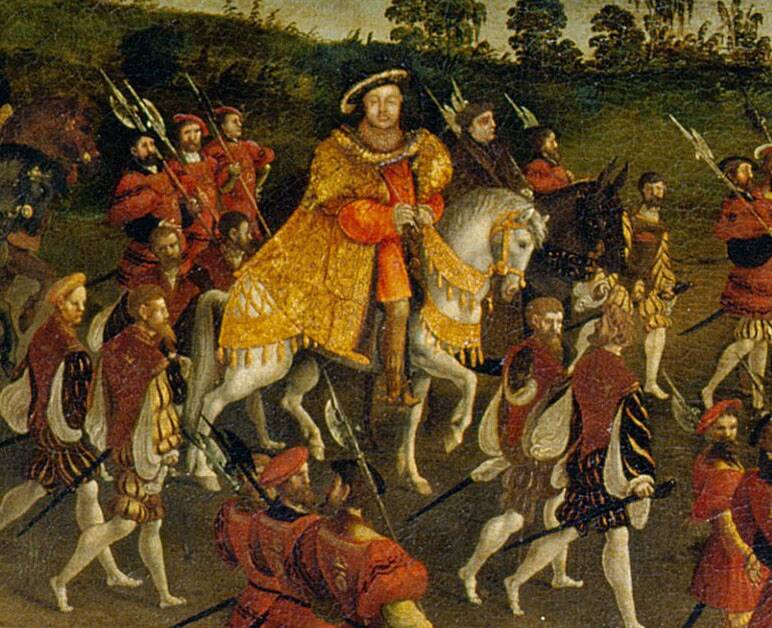
While Breeders primarily ignored the mandate against equine exports, Henry VIII developed a keen interest in Barbary Horses and the Jenet Horse (now extinct). Despite his father's limitations of exports, Henry VIII searched the European Continent and near east for the best horses, he could find. He is famously depicted astride a white stallion performing a type of dressage. Is this the first custom pet portrait? He popularized the practice of dressage amongst the Royal family.
To this day there are Royal family members who still practice this equestrian artform, which is highly disciplined and requires supreme dedication by both rider and their horse. Dressage is sometimes pursued solely for the sake of mastery, similar to the deeply spiritual approaches of dedicated artists, Japanese practitioners of Ikebana (the art of flower arranging), and martial arts practitioners of today.
Royal Dogs & Horses
The animal loving gene found its way through royal bloodlines to Queen Victoria and even the UK's sitting monarch, her majesty Queen Elizabeth II. Queen Victoria is most known for her devotion to her canine companions. Her relationship with her Cavalier King Charles Spaniel, Dash, who was her boon companion while she was still Princess Victoria, was immortalized by painter George Hayter.

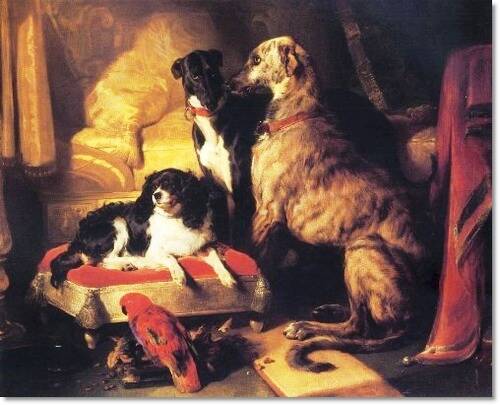
via Wikimedia.
Until her ascent to the throne in 1837, Dash was one of the Princess's few true friends. Given that she was raised in almost total isolation to protect her claim to the throne, Princess Victoria undoubtedly found great comfort and joy in her beloved Dash. Intensely over-protected and manipulated by her mother and a domineering comptroller, Victoria's loneliness was relieved only by this furry playmate; she had virtually no contact with other childrendue to her mother's multiple social and political strategies to propel this lonely girl to the throne.
Upon Dash's death, Victoria wrote this praise for his marble effigy which can be found near Adelaide Cottage's grounds at Windsor Park.
"Here lies DASH, The favourite spaniel of Her Majesty Queen Victoria, In his 10th year, His attachment was without selfishness, His playfulness without malice, His fidelity without deceit, READER, If you would be beloved and die regretted, Profit by the example of DASH"
For art and animal lovers - there are countless depictions other of the Queen and Dash as well as other Royal pets.
During the Victorian era, pet photographs rose in popularity. Like her forebears, Queen Elizabeth II loves both dogs and horses. She has taken pains to breed powerful racehorses and show jumpers. However, she is best known for her undying love of dogs, in particular Corgis. She is also a not-so-secret fan of Labradors, keeping a kennel of 15 on her Norfolk estate.
Read also: Luminescent Journey of Light

Famously, Queen Elizabeth II's pups have made appearances in animated films, the Olympic games' opening ceremony, and photographs shot by Annie Leibowitz. Not bad, for a bunch of drooling furballs with short legs and bellies that scrape the ground.
Queen Elizabeth II also is credited with developing a breed, the Dorgi, which is a cross of dachshund and corgi.
At one point her dog family numbered about thirty of the Pembroke Welsh Corgi, she broke the bank on dog names including names such as Candy, Sugar, Foxy, Bushy, Brush, Honey, Whisky, Sherry, Vulcan, Cider, Berry, Flash, Spick, Span, Tiny and Bisto Oxo.
Her Corgi's have "the Corgi room" at Buckingham Palace where they sleep in raised beds and are tended to by the Queen herself. They eat rabbit and fresh beef prepared by their own gourmet chef and at Christmas the Queen herself prepares each dog their own Christmas Stocking filled with specially chosen toys and treats.
Catherine the Great: Her Hoard of Fantastic beasts
It should not come as a shock that the fabulous and eccentric Catherine the Great was an overzealous pet parent. When she wasn't busy staging coups or getting her blood replaced with Russian blood, she needed someone to show affections. Given that her son proved rather useless, she needed someone to care for and cuddle.
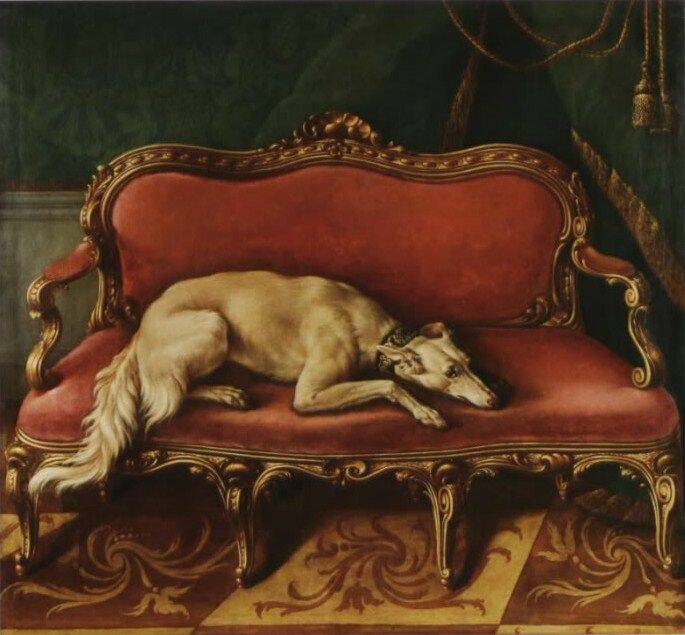
She is infamously remembered as someone who engaged in lewd acts with animals, but that is a historical untruth planted by Catherine’s detractors. She was, in fact, an animal advocate.
She had a large stable of horses she adored and even some bears. Does a bear $#%* in the woods? Yes, and also at the Russian Winter Palace. However, she most ardently adored the dogs. She erected a canine cemetery complete with a pyramid. Inside the Pyramid, her favorite dogs laid at rest, and each had a marble tombstone made for them. Zemina was a particular favorite. Zemina accompanied her mistress every day on walks across the palace grounds. The relics found inside the Pyramid remain at the Hermitage. The Pyramid, however, no longer stands. The government maintained it until the October Revolution. Perhaps the revolutionaries respected Catherine's love of animals.

Read also: Famous Still Life Paintings Last Forever In Your Mind
H. Weir the Original Cat Fancier
Royalty and eccentricity seem to run in similar circles. Perhaps it is not so much their interests but the faulty, inbred genes. However, ordinary folk has also engaged in pet portraiture and animal husbandry. Harrison Weir began his career as a designer for Silversmith, Garrards of London. The designs he created became trophies for notable horse races, including the Royal Ascot. He was a well-known illustrator of the Victorian era. Even working with the periodical "Punch Magazine." Many of his most remembered depictions are of animals. He was an early proponent of animal welfare and a noted lover of all creatures. While cats became an essential aspect of his career, at heart, Weir was truly most fascinated with birds. He drew dozens of illustrations of chickens in domestic settings and even waterfowl.
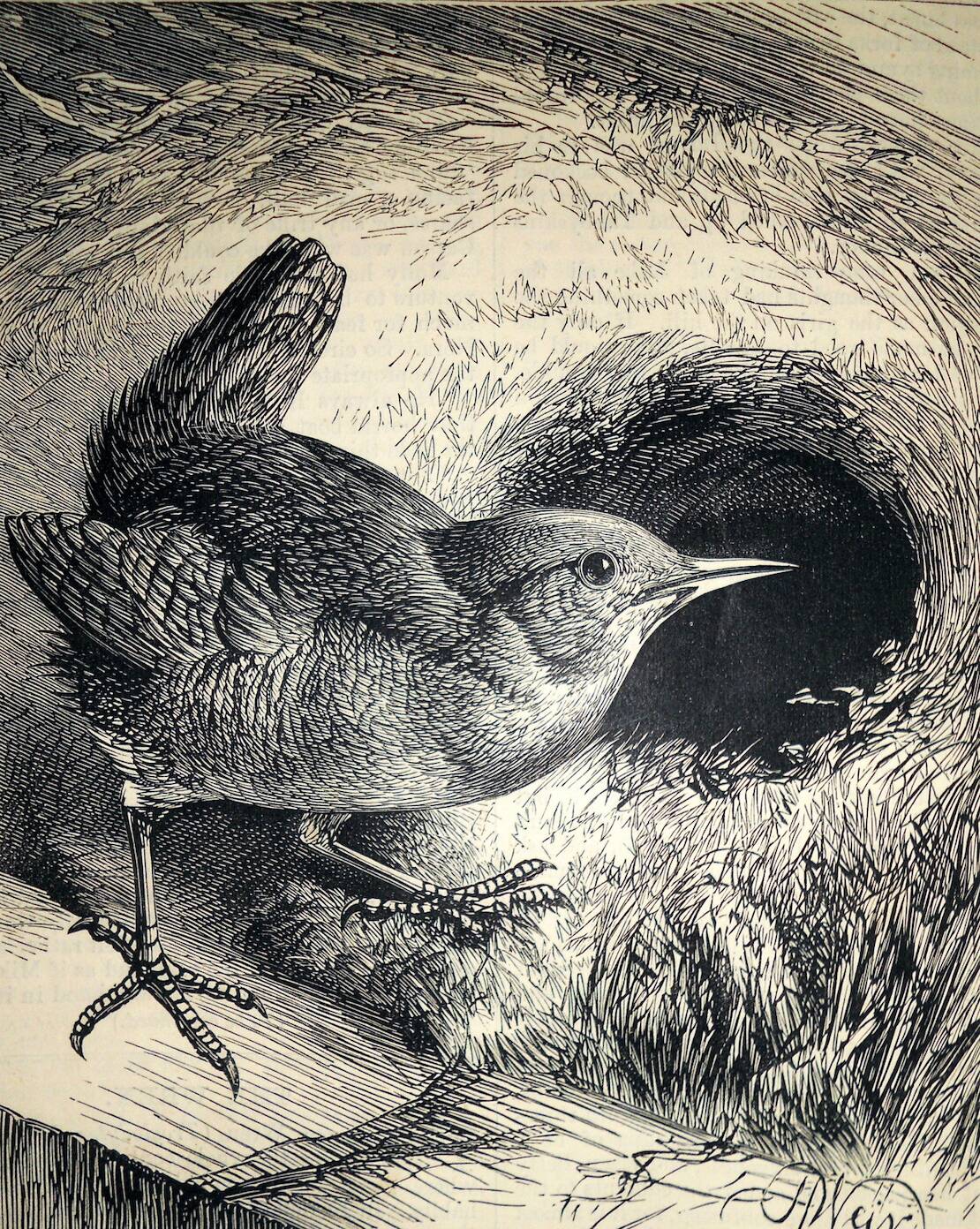
In 1871, at the Crystal Palace in Sydenham, London, the first-ever cat show was held for fancy and domestic cats. The first-ever Siamese cat entered the show ring on that day. There was even a British wildcat. Harrison Weir, alongside his brother, John Weir (a known judge of birds and ornithologist), and J.Cumming Macdona (dog judge and St. Bernard breeder), judged the felines. The public response was more extensive than expected, drawing two days of enormous crowds. Until then, there was no public interest in domestic animals like the cat as anything more than a working member of a farm. Weir made a point of including areas for working-class folks to participate in cat shows. Shockingly, it was small pets that offered some social equity to the people during the Victorian Era. Weir drew many pictures of cats and created children's literature about animal welfare and pet ownership. Generations of children engaged with pet ownership due to his innate respect for feathered, feline, and furry beasts.
Read also: The Intense and Fiery Nature of the Color Red
Many Artists are Proud Pet Parents and Animal Lovers
Being an artist sometimes precludes an individual from entirely participating in everyday society. It is as though the brilliant thoughts in their minds are too loud for normalcy, which makes a strong case for pets' presence in their lives. Pets are trustworthy and also incapable of speech, making them an ideal non-judgmental companion. Picasso, Warhol, Matisse, and Lucian Freud are notably for their companions. All the artists have even included their beloved pets in some of their well-known works.

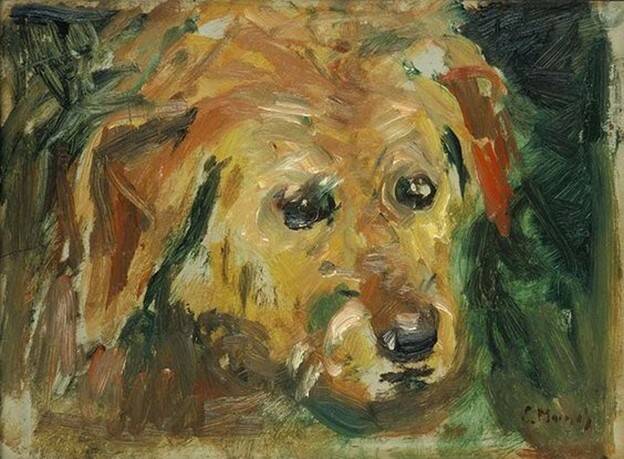
Matisse has shown his pet doves in Les Oiseaux and his cat in Tea in the Garden. Picasso had Lump, a frequent subject, the only companion to whom Picasso was ever genuinely loyal. The level of loyalty cannot say the same for his relationships with his wives.
Norwegian artist Edvard Munch loved all sizes of dogs; his pets ranged from a St. Bernard to Fox Terrier, shown in Dogs Face (1927). Known for his profoundly psychological portrayals (yes, he painted "The Scream"), Munch bonded even more deeply with his animals after withdrawing from society in 1908, following his anxiety attacks over the deaths of his mother and sister. Known for taking his dogs with him everywhere, including the cinema, it could be said that Edvard Munch was much happier in the world when he had his 'service animals' with him.

Andy Warhol and His Dog Archie, c.1973,
via Pinterest
Andy Warhol owned various cats, all named Sam. However, his heart belonged to Archie the Dachshund. Archie sat for a pup portrait done by Warhol's friend Jamie Wyeth.
Pets humanize (pet portrait) artists. They, too, may pat a strange dog on the head or makeup songs to annoy their pets.
Pets are a redeeming factor for humanity. With animals, humans can show their genuine kindness and act upon sometimes repressed feelings of love. Problematic leaders of yore seem less frightening when you know they loved their dog (or bear).
Bonding with an animal transcends language as we know it, but the power of our bonds with them can be inexpressibly deep. Without words, our pets speak to us with their eyes, sometimes, or with their trust, or with the heated little rumbles of their purrs, or with the subtle flick of their tails. Our pets can awaken our hearts in ways that humans rarely do.
So often, pets become subjects because of the unadulterated love we feel for them. Pets live short lives compared to their owners, but their impact on the lives they touched is lasting. Immortalizing these pivotal figures in art is the only way to repay our debt to them.
Read also: Absence of Colors: Three Symbolic Examples of Black and White Artworks
____________________________________________________________________________________________________
Nicole Lania is an art historian and writer who has years of experience finding genuine creativity in a world of thinly veiled reproductions. She earned a master’s degree from New York University with a focus on contemporary art and writing; her thesis was on the impact Christo’s The Gates had on the cultural capital of Central Park and the surrounding neighborhoods. She can be found walking her dog, Tucker through the New England wilderness or baking pastries in her kitchen. Nicole can be found on Instagram @nik.lania, Twitter @NicoleLania1, or her website http://www.nicolelania.com/.
Bibliography
Fanimal. 2019. The History of Pet Portraits. February 10. Accessed March 1, 2021. https://fanimal.online/the-history-of-pet-portraits/.
Glickman, Yevgenia. 1995. A Dog's Life. Accessed March 15, 2021. http://www.friends-partners.org/oldfriends/spbweb/lifestyl/124/dogslife.html.
Leibovitz, Annie. 2016. Vanity Fair. May 31. Accessed March 15, 2021. https://www.vanityfair.com/style/2016/05/queen-elizabeth-exclusive-cover-annie-leibovitz.
Noel, Courtney. 2020. An Equestian Life. March 17. Accessed March 15, 2021. http://anequestrianlife.com/2020/03/king-henry-viii-and-his-horses/#:~:text=He%20was%20especially%20found%20of,a%20state%20enforced%20breeding%20program.
Smithson, John G. 2012. Harrison Weir. Accessed March 15, 2021. https://harrisonweir.com/.
Wikipedia. 2019. Dash. April 6. Accessed March 15, 2021. https://en.wikipedia.org/wiki/Dash_(spaniel).


